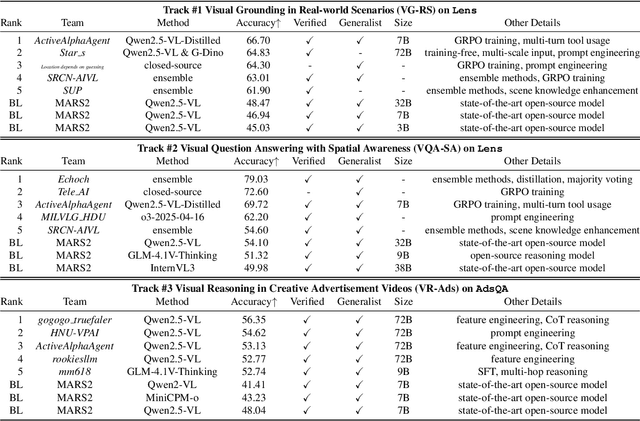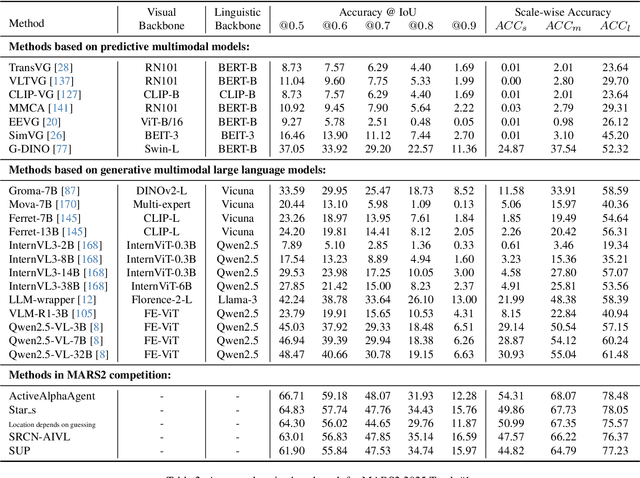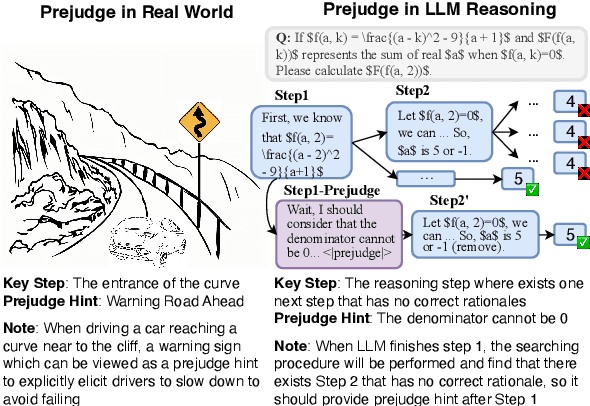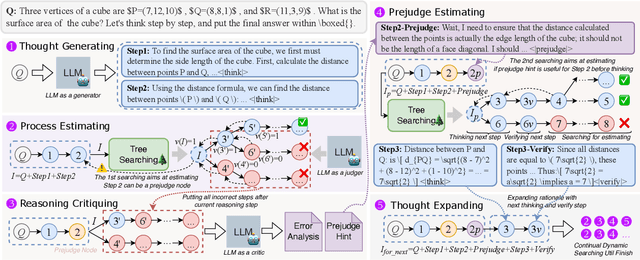Jianing Wang
Autoformalizer with Tool Feedback
Oct 08, 2025Abstract:Autoformalization addresses the scarcity of data for Automated Theorem Proving (ATP) by translating mathematical problems from natural language into formal statements. Efforts in recent work shift from directly prompting large language models to training an end-to-end formalizer model from scratch, achieving remarkable advancements. However, existing formalizer still struggles to consistently generate valid statements that meet syntactic validity and semantic consistency. To address this issue, we propose the Autoformalizer with Tool Feedback (ATF), a novel approach that incorporates syntactic and consistency information as tools into the formalization process. By integrating Lean 4 compilers for syntax corrections and employing a multi-LLMs-as-judge approach for consistency validation, the model is able to adaptively refine generated statements according to the tool feedback, enhancing both syntactic validity and semantic consistency. The training of ATF involves a cold-start phase on synthetic tool-calling data, an expert iteration phase to improve formalization capabilities, and Direct Preference Optimization to alleviate ineffective revisions. Experimental results show that ATF markedly outperforms a range of baseline formalizer models, with its superior performance further validated by human evaluations. Subsequent analysis reveals that ATF demonstrates excellent inference scaling properties. Moreover, we open-source Numina-ATF, a dataset containing 750K synthetic formal statements to facilitate advancements in autoformalization and ATP research.
MARS2 2025 Challenge on Multimodal Reasoning: Datasets, Methods, Results, Discussion, and Outlook
Sep 17, 2025



Abstract:This paper reviews the MARS2 2025 Challenge on Multimodal Reasoning. We aim to bring together different approaches in multimodal machine learning and LLMs via a large benchmark. We hope it better allows researchers to follow the state-of-the-art in this very dynamic area. Meanwhile, a growing number of testbeds have boosted the evolution of general-purpose large language models. Thus, this year's MARS2 focuses on real-world and specialized scenarios to broaden the multimodal reasoning applications of MLLMs. Our organizing team released two tailored datasets Lens and AdsQA as test sets, which support general reasoning in 12 daily scenarios and domain-specific reasoning in advertisement videos, respectively. We evaluated 40+ baselines that include both generalist MLLMs and task-specific models, and opened up three competition tracks, i.e., Visual Grounding in Real-world Scenarios (VG-RS), Visual Question Answering with Spatial Awareness (VQA-SA), and Visual Reasoning in Creative Advertisement Videos (VR-Ads). Finally, 76 teams from the renowned academic and industrial institutions have registered and 40+ valid submissions (out of 1200+) have been included in our ranking lists. Our datasets, code sets (40+ baselines and 15+ participants' methods), and rankings are publicly available on the MARS2 workshop website and our GitHub organization page https://github.com/mars2workshop/, where our updates and announcements of upcoming events will be continuously provided.
ScienceBoard: Evaluating Multimodal Autonomous Agents in Realistic Scientific Workflows
May 26, 2025



Abstract:Large Language Models (LLMs) have extended their impact beyond Natural Language Processing, substantially fostering the development of interdisciplinary research. Recently, various LLM-based agents have been developed to assist scientific discovery progress across multiple aspects and domains. Among these, computer-using agents, capable of interacting with operating systems as humans do, are paving the way to automated scientific problem-solving and addressing routines in researchers' workflows. Recognizing the transformative potential of these agents, we introduce ScienceBoard, which encompasses two complementary contributions: (i) a realistic, multi-domain environment featuring dynamic and visually rich scientific workflows with integrated professional software, where agents can autonomously interact via different interfaces to accelerate complex research tasks and experiments; and (ii) a challenging benchmark of 169 high-quality, rigorously validated real-world tasks curated by humans, spanning scientific-discovery workflows in domains such as biochemistry, astronomy, and geoinformatics. Extensive evaluations of agents with state-of-the-art backbones (e.g., GPT-4o, Claude 3.7, UI-TARS) show that, despite some promising results, they still fall short of reliably assisting scientists in complex workflows, achieving only a 15% overall success rate. In-depth analysis further provides valuable insights for addressing current agent limitations and more effective design principles, paving the way to build more capable agents for scientific discovery. Our code, environment, and benchmark are at https://qiushisun.github.io/ScienceBoard-Home/.
Do Large Language Models Excel in Complex Logical Reasoning with Formal Language?
May 22, 2025Abstract:Large Language Models (LLMs) have been shown to achieve breakthrough performance on complex logical reasoning tasks. Nevertheless, most existing research focuses on employing formal language to guide LLMs to derive reliable reasoning paths, while systematic evaluations of these capabilities are still limited. In this paper, we aim to conduct a comprehensive evaluation of LLMs across various logical reasoning problems utilizing formal languages. From the perspective of three dimensions, i.e., spectrum of LLMs, taxonomy of tasks, and format of trajectories, our key findings are: 1) Thinking models significantly outperform Instruct models, especially when formal language is employed; 2) All LLMs exhibit limitations in inductive reasoning capability, irrespective of whether they use a formal language; 3) Data with PoT format achieves the best generalization performance across other languages. Additionally, we also curate the formal-relative training data to further enhance the small language models, and the experimental results indicate that a simple rejected fine-tuning method can better enable LLMs to generalize across formal languages and achieve the best overall performance. Our codes and reports are available at https://github.com/jiangjin1999/FormalEval.
CL-CaGAN: Capsule differential adversarial continuous learning for cross-domain hyperspectral anomaly detection
May 17, 2025



Abstract:Anomaly detection (AD) has attracted remarkable attention in hyperspectral image (HSI) processing fields, and most existing deep learning (DL)-based algorithms indicate dramatic potential for detecting anomaly samples through specific training process under current scenario. However, the limited prior information and the catastrophic forgetting problem indicate crucial challenges for existing DL structure in open scenarios cross-domain detection. In order to improve the detection performance, a novel continual learning-based capsule differential generative adversarial network (CL-CaGAN) is proposed to elevate the cross-scenario learning performance for facilitating the real application of DL-based structure in hyperspectral AD (HAD) task. First, a modified capsule structure with adversarial learning network is constructed to estimate the background distribution for surmounting the deficiency of prior information. To mitigate the catastrophic forgetting phenomenon, clustering-based sample replay strategy and a designed extra self-distillation regularization are integrated for merging the history and future knowledge in continual AD task, while the discriminative learning ability from previous detection scenario to current scenario is retained by the elaborately designed structure with continual learning (CL) strategy. In addition, the differentiable enhancement is enforced to augment the generation performance of the training data. This further stabilizes the training process with better convergence and efficiently consolidates the reconstruction ability of background samples. To verify the effectiveness of our proposed CL-CaGAN, we conduct experiments on several real HSIs, and the results indicate that the proposed CL-CaGAN demonstrates higher detection performance and continuous learning capacity for mitigating the catastrophic forgetting under cross-domain scenarios.
CL-BioGAN: Biologically-Inspired Cross-Domain Continual Learning for Hyperspectral Anomaly Detection
May 17, 2025Abstract:Memory stability and learning flexibility in continual learning (CL) is a core challenge for cross-scene Hyperspectral Anomaly Detection (HAD) task. Biological neural networks can actively forget history knowledge that conflicts with the learning of new experiences by regulating learning-triggered synaptic expansion and synaptic convergence. Inspired by this phenomenon, we propose a novel Biologically-Inspired Continual Learning Generative Adversarial Network (CL-BioGAN) for augmenting continuous distribution fitting ability for cross-domain HAD task, where Continual Learning Bio-inspired Loss (CL-Bio Loss) and self-attention Generative Adversarial Network (BioGAN) are incorporated to realize forgetting history knowledge as well as involving replay strategy in the proposed BioGAN. Specifically, a novel Bio-Inspired Loss composed with an Active Forgetting Loss (AF Loss) and a CL loss is designed to realize parameters releasing and enhancing between new task and history tasks from a Bayesian perspective. Meanwhile, BioGAN loss with L2-Norm enhances self-attention (SA) to further balance the stability and flexibility for better fitting background distribution for open scenario HAD (OHAD) tasks. Experiment results underscore that the proposed CL-BioGAN can achieve more robust and satisfying accuracy for cross-domain HAD with fewer parameters and computation cost. This dual contribution not only elevates CL performance but also offers new insights into neural adaptation mechanisms in OHAD task.
Prejudge-Before-Think: Enhancing Large Language Models at Test-Time by Process Prejudge Reasoning
Apr 18, 2025



Abstract:In this paper, we introduce a new \emph{process prejudge} strategy in LLM reasoning to demonstrate that bootstrapping with process prejudge allows the LLM to adaptively anticipate the errors encountered when advancing the subsequent reasoning steps, similar to people sometimes pausing to think about what mistakes may occur and how to avoid them, rather than relying solely on trial and error. Specifically, we define a prejudge node in the rationale, which represents a reasoning step, with at least one step that follows the prejudge node that has no paths toward the correct answer. To synthesize the prejudge reasoning process, we present an automated reasoning framework with a dynamic tree-searching strategy. This framework requires only one LLM to perform answer judging, response critiquing, prejudge generation, and thought completion. Furthermore, we develop a two-phase training mechanism with supervised fine-tuning (SFT) and reinforcement learning (RL) to further enhance the reasoning capabilities of LLMs. Experimental results from competition-level complex reasoning demonstrate that our method can teach the model to prejudge before thinking and significantly enhance the reasoning ability of LLMs. Code and data is released at https://github.com/wjn1996/Prejudge-Before-Think.
The Role of Visual Modality in Multimodal Mathematical Reasoning: Challenges and Insights
Mar 06, 2025Abstract:Recent research has increasingly focused on multimodal mathematical reasoning, particularly emphasizing the creation of relevant datasets and benchmarks. Despite this, the role of visual information in reasoning has been underexplored. Our findings show that existing multimodal mathematical models minimally leverage visual information, and model performance remains largely unaffected by changes to or removal of images in the dataset. We attribute this to the dominance of textual information and answer options that inadvertently guide the model to correct answers. To improve evaluation methods, we introduce the HC-M3D dataset, specifically designed to require image reliance for problem-solving and to challenge models with similar, yet distinct, images that change the correct answer. In testing leading models, their failure to detect these subtle visual differences suggests limitations in current visual perception capabilities. Additionally, we observe that the common approach of improving general VQA capabilities by combining various types of image encoders does not contribute to math reasoning performance. This finding also presents a challenge to enhancing visual reliance during math reasoning. Our benchmark and code would be available at \href{https://github.com/Yufang-Liu/visual_modality_role}{https://github.com/Yufang-Liu/visual\_modality\_role}.
LangYa: Revolutionizing Cross-Spatiotemporal Ocean Forecasting
Dec 24, 2024Abstract:Ocean forecasting is crucial for both scientific research and societal benefits. Currently, the most accurate forecasting systems are global ocean forecasting systems (GOFSs), which represent the ocean state variables (OSVs) as discrete grids and solve partial differential equations (PDEs) governing the transitions of oceanic state variables using numerical methods. However, GOFSs processes are computationally expensive and prone to cumulative errors. Recently, large artificial intelligence (AI)-based models significantly boosted forecasting speed and accuracy. Unfortunately, building a large AI ocean forecasting system that can be considered cross-spatiotemporal and air-sea coupled forecasts remains a significant challenge. Here, we introduce LangYa, a cross-spatiotemporal and air-sea coupled ocean forecasting system. Results demonstrate that the time embedding module in LangYa enables a single model to make forecasts with lead times ranging from 1 to 7 days. The air-sea coupled module effectively simulates air-sea interactions. The ocean self-attention module improves network stability and accelerates convergence during training, and the adaptive thermocline loss function improves the accuracy of thermocline forecasting. Compared to existing numerical and AI-based ocean forecasting systems, LangYa uses 27 years of global ocean data from the Global Ocean Reanalysis and Simulation version 12 (GLORYS12) for training and achieves more reliable deterministic forecasting results for OSVs. LangYa forecasting system provides global ocean researchers with access to a powerful software tool for accurate ocean forecasting and opens a new paradigm for ocean science.
HEIE: MLLM-Based Hierarchical Explainable AIGC Image Implausibility Evaluator
Nov 26, 2024



Abstract:AIGC images are prevalent across various fields, yet they frequently suffer from quality issues like artifacts and unnatural textures. Specialized models aim to predict defect region heatmaps but face two primary challenges: (1) lack of explainability, failing to provide reasons and analyses for subtle defects, and (2) inability to leverage common sense and logical reasoning, leading to poor generalization. Multimodal large language models (MLLMs) promise better comprehension and reasoning but face their own challenges: (1) difficulty in fine-grained defect localization due to the limitations in capturing tiny details; and (2) constraints in providing pixel-wise outputs necessary for precise heatmap generation. To address these challenges, we propose HEIE: a novel MLLM-Based Hierarchical Explainable image Implausibility Evaluator. We introduce the CoT-Driven Explainable Trinity Evaluator, which integrates heatmaps, scores, and explanation outputs, using CoT to decompose complex tasks into subtasks of increasing difficulty and enhance interpretability. Our Adaptive Hierarchical Implausibility Mapper synergizes low-level image features with high-level mapper tokens from LLMs, enabling precise local-to-global hierarchical heatmap predictions through an uncertainty-based adaptive token approach. Moreover, we propose a new dataset: Expl-AIGI-Eval, designed to facilitate interpretable implausibility evaluation of AIGC images. Our method demonstrates state-of-the-art performance through extensive experiments.
 Add to Chrome
Add to Chrome Add to Firefox
Add to Firefox Add to Edge
Add to Edge